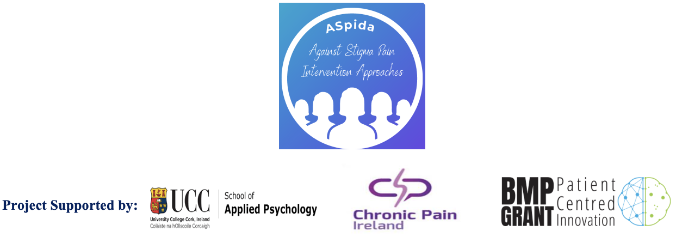- PPI Case Studies
- PPI Resources
- Introduction to PPI
- Difference between PPI and qualitative research
- Involving children and young people in research
- PPI and doctoral research
- PPI in systematic reviews
- PPI in qualitative analysis
- Reporting PPI
- PPI in funding applications
- Budgeting for PPI
- PPI and lab-based research
- Evaluating PPI
- Events and Seminars
- Previous Summer Students
- News and Events
- About Us
- PPI Seed Funding Scheme 2023
- PPI Shared Learning Group for PhD Researchers
- PPI Ignite Network@ UCC Mailing List
- Digital Badge
ASpida: Against Stigma pain intervention approaches

Brief overview of the project
ASpida is a research development program run in collaboration with the School of Applied Psychology, UCC and Chronic Pain Ireland (CPI; https://www.chronicpain.ie/). The program aspires to reduce stigma in individuals with chronic pain by developing an against-stigma, self-care program to be delivered to local communities and integrated into CPI’s services.
ASpida employs a unified behavior change approach, called Psychological flexibility for Chronic Pain and patient-centered participatory activities. The program attempts to stop stigma by teaching individuals with Chronic Pain (CP) several techniques on how to respond to stigma imposed by others or to cope with self-stigmatization, including unwelcome thoughts and emotions. ASpida prioritizes empowering individuals to engage in value-consistent activities even in the presence of pain and stigmatized experiences. It focuses on what individuals can personally do to tackle the effects of stigma, rather than intervene in the social context that feeds into stigma.
Description of Public and Patient Involvement (PPI) in this project
We set up a patient involvement group of individuals with CP to support the research activities of ASpida. PPI members participated in 12 online meetings (1 ½ /week) working together towards the development of a digital research platform that consisted of several activities (e.g., exercises the research group attempts to evaluate with findings from this evaluation attempting to inform the ASpida’s program).
During the PPI meetings, members of the ASpida PPI group:
- contributed to the development of ASpida’s protocol by testing and modifying exercises on psychological flexibility skills.
- assisted the research team to develop prototypes, including the ASpida’s digital artifacts, illustrating videos and animations with psychological skills to tackle the effects of stigma.
- enriched the content of several psychological exercises that will be tested in a quasi-experimental usability study, sharing their personal stigmatized experiences and developing stigma related scenarios and stories.
- Co-facilitating focus groups and deliver the ASpida program to local communities (future task)
- Train other members of CPI in delivering the program (future task)
Who is/was involved?
Members of CPI who have a set diagnosis of chronic pain condition, sufficient English language abilities and access to stable internet connection were invited to become members of the ASpida’s PPI group. We conducted interviews and nine out for 43 of the interviewees, were become members of ASpida’s PPI group. The mean age of the group was 52 years, with three of them being retired, three occupied and two under compensation leave. All members were Irish representing different counties.
Challenges and/or solutions
ASpida’s PPI challenges:
- Lack of engagement was one of the main challenges we faced. After the completion of the 6th PPI meeting some members left the group for mainly other obligations and health issues, while others were less motivated to participate.
- PPI members appeared less motivated during the training process and the presentation of the theoretical framework ASpida’s.
ASpida’s Solutions:
- The research team discussed dropouts with the remaining PPI members that considered the lack of engagement resulting due to the expansion of ASpida’s sessions. Also, some members developed what is now known as “zoom fatigue” as all meeting occurred, digitally. In response to this, the remaining members stood themselves and proposed an in-person group meeting so that the group could complete the tasks in preparation of the research activities (e.g. prepare the digital artifacts, assist in the scenarios development, record activities, etc.). Due to the Covid-19 public health guidelines this was impossible, and the group attempted to support the ASpida research development by allocating tasks within themselves.
- ASpida’s team recognized the lack of motivation for the theory behind the program and shorten this part.
What difference did public involvement make?
- PPI members contributed to make ASpida’s protocol approachable and less emotionally demanding for stigmatized individuals with CP.
- Members modified exercises, illustrating in a lay way several Psychological skills and experiential exercises, making the concept understandable to everyone.
- By revising multiple drafts, PPI members attempted to ensure that the testing exercises were culturally acceptable.
What would you advise researchers about involvement?
We would advise researchers to dedicate time in team bonding, as we considered this as an important element for an effective PPI involvement. This can be enhanced through ice-breaking exercises or/and organizing in-person meetings. Also, they may start by involving PPI members whenever there is something that needs their involvement. Short in time meeting seem to work best for individuals with CP.
